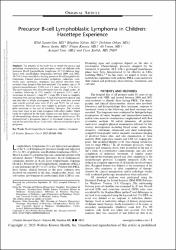Precursor B-cell lymphoblastic lymphoma in children: hacettepe experience

View/
Access
info:eu-repo/semantics/embargoedAccessDate
2023Author
Susam Sen, HilalYalçın, Bilgehan
Orhan, Diclehan
Aydın, Burca
Kurucu, Nilgün
Varan, Ali
Üner, Ayşegül
Kutluk, Tezer
Metadata
Show full item recordCitation
Susam-Sen, H., Yalcin, B., Orhan, D., Aydin, B., Kurucu, N., Varan, A., ... & Kutluk, T. (2023). Precursor B-cell Lymphoblastic Lymphoma in Children: Hacettepe Experience. Journal of Pediatric Hematology/Oncology, 10-1097.Abstract
The purpose of the study was to review the clinical and pathologic characteristics and treatment results of children with precursor B-cell lymphoblastic lymphoma. Of 530 children diagnosed with non-Hodgkin lymphomas between 2000 and 2021, 39 (7.4%) were identified as having precursor B-cell lymphoblastic lymphoma. Clinical characteristics, pathologic, radiologic, laboratory data, treatments, responses, and overall outcomes were recorded from hospital files and analyzed. The median age of 39 patients (males/females, 23/16) was 8.3 years (range 1.3 to 16.1). The most common sites of involvement were the lymph nodes. At a median follow-up of 55.8 months, 14 patients (35%) had a recurrence of disease (11 stage IV, 3 stage III); 4 were in complete remission with salvage therapies, 9 died of progressive disease and one died due to febrile neutropenia. Five-year event-free survival and overall survival rates were 65.4% and 78.3% for all cases, respectively. Survival rates were higher in patients with a complete remission at the end of induction therapies. The survival rates were lower in our study compared with other studies, which could be explained by the high relapse rate and higher incidence of advanced-stage disease due to bone marrow involvement. We demonstrated a prognostic impact of treatment response at the end of the induction phase. Cases with a disease relapse have poor prognosis.















